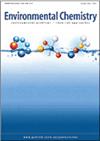南极南大洋海洋次生气溶胶的形成
IF 2.3
4区 环境科学与生态学
Q3 CHEMISTRY, ANALYTICAL
引用次数: 0
摘要
气溶胶尤其是海洋次生气溶胶中的水溶性离子(wsi)参与海洋边界层云凝结核(CCN)的形成,进而影响全球气候。本研究分析了南大洋夏季次生气溶胶的形成路径和形态,探讨了南大洋夏季次生气溶胶的成因。我们的研究为这些次生气溶胶在SO中的形成机制提供了新的数据,对我们对全球气候变化的理解有潜在的影响。气溶胶尤其是海洋次生气溶胶中的水溶性离子(wsi)可能参与海洋边界层云凝结核(CCN)的形成并影响全球气候。然而,目前对极地海洋次生气溶胶的背景浓度及其形成机制的研究还很缺乏。利用南大洋气体和气溶胶成分原位监测系统分析了气溶胶中wsi的高时间分辨率浓度,以确定海洋二次气溶胶包括甲烷磺酸(MSA)、SO42−和NO3−的形成。wsi的平均小时质量浓度为663 ng m−3,次生气溶胶占wsi的49.8±20.2%。SO42−和NO3−主要通过均相反应生成,而均相反应和非均相反应共同促进了SO中气溶胶中MSA−的生成。海冰的融化和叶绿素-a (Chl-a)浓度的增加是MSA−形成的主要原因。海洋气溶胶中存在MSA-Na、MSA-NH4+、MSA-SO42−、MSA-Mg、MSA-K和MSA-Cl。二次无机气溶胶主要以NH4NO3、(NH4)2SO4、Na2SO4和MgSO4的形式存在。研究结果丰富了大气中WSI浓度和二次气溶胶形成机制的数据。本文章由计算机程序翻译,如有差异,请以英文原文为准。
Formation of marine secondary aerosols in the Southern Ocean, Antarctica
Environmental context Water soluble ions (WSIs) in aerosols, especially in marine secondary aerosols, can participate in the formation of cloud condensation nuclei (CCN) in the marine boundary layer, which can affect global climate. In our study, in-situ gas and aerosol compositions were analysed to explore the formation paths and forms of secondary aerosols in the Southern Ocean (SO) in summer. Our study provided novel data on these formation mechanisms of secondary aerosols in the SO, with potential impacts on our understanding of global climate change. Abstract Water-soluble ions (WSIs) in aerosols, especially marine secondary aerosols, may participate in the formation of cloud condensation nuclei (CCN) in the marine boundary layer and affect the global climate. However, there is still a lack of studies on the background concentrations and the formation mechanisms of marine secondary aerosols in polar areas. High time resolution concentrations of WSIs in aerosols were analysed by an in situ gas and aerosol composition monitoring system in the Southern Ocean (SO) to identify the formation of marine secondary aerosols including methanesulfonic acid (MSA), SO42− and NO3−. The average hourly mass concentration of WSIs was 663 ng m−3 and secondary aerosols accounted for 49.8 ± 20.2 % of the WSIs. SO42− and NO3− were mainly formed by homogeneous reaction, whereas homogeneous and heterogeneous reactions together contributed to the formation of MSA− in aerosols in the SO. The melting of sea ice and the increase of chlorophyll-a (Chl-a) concentration contributed to the formation of MSA−. MSA-Na, MSA-NH4+, MSA-SO42−, MSA-Mg, MSA-K and MSA-Cl existed in marine aerosols. Secondary inorganic aerosols existed mainly in the forms of NH4NO3, (NH4)2SO4, Na2SO4 and MgSO4. The results enrich the data of WSI concentrations and formation mechanisms of secondary aerosols in the SO.
求助全文
通过发布文献求助,成功后即可免费获取论文全文。
去求助
来源期刊

Environmental Chemistry
环境科学-分析化学
CiteScore
4.50
自引率
0.00%
发文量
0
审稿时长
2.7 months
期刊介绍:
Environmental Chemistry publishes manuscripts addressing the chemistry of the environment (air, water, earth, and biota), including the behaviour and impacts of contaminants and other anthropogenic disturbances. The scope encompasses atmospheric chemistry, geochemistry and biogeochemistry, climate change, marine and freshwater chemistry, polar chemistry, fire chemistry, soil and sediment chemistry, and chemical aspects of ecotoxicology. Papers that take an interdisciplinary approach, while advancing our understanding of the linkages between chemistry and physical or biological processes, are particularly encouraged.
While focusing on the publication of important original research and timely reviews, the journal also publishes essays and opinion pieces on issues of importance to environmental scientists, such as policy and funding.
Papers should be written in a style that is accessible to those outside the field, as the readership will include - in addition to chemists - biologists, toxicologists, soil scientists, and workers from government and industrial institutions. All manuscripts are rigorously peer-reviewed and professionally copy-edited.
Environmental Chemistry is published with the endorsement of the Commonwealth Scientific and Industrial Research Organisation (CSIRO) and the Australian Academy of Science.
 求助内容:
求助内容: 应助结果提醒方式:
应助结果提醒方式:


